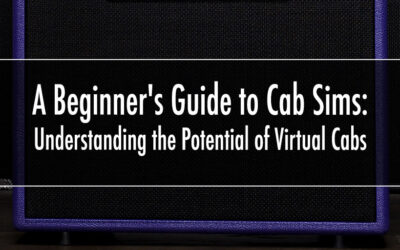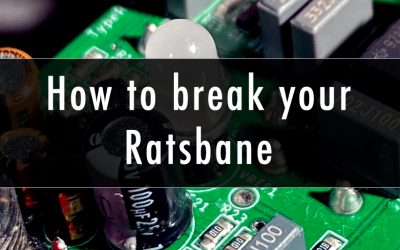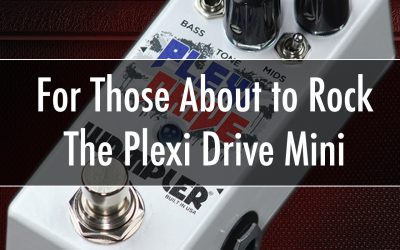UniVibe sounds better pre gain… there, I said it. Now, I know this is a subjective statement, but you know, the VAST majority of the people I know and have spoken to consider the UniVibe style circuit to be perfectly placed pre gain stages. Of course, there is going to be someone who is already googling for their favourite picture of Jimi with a FuzzFace into a Vibe into his Marshall’s… of course, the main issue here is that Jimi’s amps were always cooking, so the UniVibe WAS going into dirt, just it also had some going into it as well – the thing to remember here is that the last thing in the chain, in the case of Jimi and Trower, their amps are on pretty well full tilt so that is what is deciding the overall tone. Now, if they were going into very clean amps…
Why does this happen? What changes does an effect like a UniVibe make to the signal that makes it SO picky about signal chain placement. Most effects can sit happily either pre or post (although they will sound different) I can’t think of one that is so very different dependent on placement. To my ears, pre gain the Vibe sounds fat and exciting, and post gain is sounds thin and weedy. I know that, once again, it’s just my opinion, but that appears to be the general consensus. So much so, I broke out my trusty Helix Native and used the same riff to show the difference. So, same riff, just moving the vibe from front of gain (amp is a basic Mashall model going into 2x 4×12”, one with a 57 and the other a 411). I recorded the opening riff of a great little song called “Mystery Song” by the mighty Status Quo and sliced it down the middle to separate the tracks and put the UniVibe in a different place – the only change in the chain is that the second part of the riff has the UniVibe moved from first in chain to behind the amp and before the speakers.
To explain this, the best thing to do is to go into the mechanics of a UniVibe style effect to understand why it works in the different positions. Basically, a UniVibe is a 4 stage filter that creates 2 notches that are moving around each other (worth noting here, the UniVibe is more of a filter effect, it’s kinda misplaced as a modulation, but…). The Q on these notches is quite narrow so the human ear is hearing the emphasis on the space between the notches. When the LFO (low frequency oscillator, the thing that gives the movement sound, the ‘sweep’) is moving up and down, we ‘pick up’ that space between and inadvertently concentrate on that. As the range of the sweep isn’t the complete, it cuts off and comes back the other direction. Because of the two notches, this is what creates that out of phase/wet sound we’ve all come to love.
The reason it gives the impression of being more comfortable pre gain, is because as the filters are moving around, it excites the harmonics in the dirt that emphasises them in a way that is pleasing to the ear, when it is post dirt, those harmonics are in place before so the notches are removing them in specific places, and the main section in the middle that we hear is sounding flat. When that hump hits the dirt and clips (overdrives), the dirt pedal/amp gets all excited and makes it pleasing to the ear, also, a good dirt stage (and most not so good ones) will compress the signal somewhat as well, so it’s bringing in all those pleasant frequencies into a nicer sound and focusing our ears to the sounds, once the ‘compression’ is before it, everything is flying freely around and there is no focus. In order to make UniVibe sound the way we perceive it should sound, it needs the compression of the gain stages (whether it be the dirt pedals or driven amp) to bring it back into control, not allow the top end to run around freely and be “the UniVibe” – when it goes behind, it almost turns into another effect that maybe should have a different name? What should it be called?
OK, so – my dodgy sound example – Hopefully you’ll notice that when the riff moves to track 2, the sound does become instantly weaker and more leaning towards the top end – it starts to sound very filtered (which is what the effect is doing) – this is because the filter in the UniVibe now has free reign over the tone and the parts it’s emphasising are there for you to hear – when it goes pre gain the gain stages are flattening everything out, compressing it all and bringing it all under control. You can see with the EQ graph (although it’s quite subtle, but it’s there) how those frequencies are allowed to be more prominent.
For this recording I have increased the gain element and made the vibe more prominent, just to emphasise the effect – it’s not designed to be a soundalike!
Original recording:



I have also found that it sounds better pre-gain/overdrive but not really knowing what the mechanics of the univibe entail my intuition was there’s something, to my mind anyway, not the same but nominally similar to my wah going on and it’s definitely a pre-gain effect so….
Just getting a little insight into how the UV works is fascinating but even more striking though is someone outside the UK talking about ‘the Quo’. Now that truly is eye opening, great song too ????
I wrote this, and I’m very much in the UK!!
I use a BBE Soul Vibe and find that it sounds better for my purposes with my Wampler Euphoria post gain. The effect sounds too pronounced pre gain. I can get a Nils Lofgren or Warren Haynes fast vibe shimmer or a slow Leslie type David Gilmour or Eric Clapton sound more easily after the Euphoria.
i have a soul vibe too. i love the univibe sound but found the effect to subtle since is 2 stage i think. i oppend the back plate and played with the internal knob. i love it now
What’s weird is on my old korg X5D keyboard I couldn’t get overdriven leslie effect to sound good till I put the OD before the leslie? Also phasers and flangers sound better after OD. I found out the hard way the Uni vibe sounds better before OD. It just seems counter intuitive?
Just Received A EHX Good Vibes and sounsa great after Wampler Ego and Tumnus Deluxe.
The Tumnus Gives It More Throb.
I have a Wampler Ego and Tumnus in Front of a TC Jims 45
Output of the Jims 45 to modulation pedal for the best results.
Tape Delay Pedals After the Vibe pedal is 70s Magic.
I know I’m late to this party, but I moved my TC Electronic Vibraclone before my overdrive pedals and used on a FB concert yesterday because of this article. It made a HUGE difference. Thank you for your post! Peace, Monroe
A pleasure Monroe
Now further to this, Univibe pre or post compression?? I guess using the same logic it would be pre? I run my comp pre gain normally
Try this…
Tuner -> Octaves -> vibes/filters/wahs -> Overdrives -> Compressor -> amp
(Effects loop out) -> modulation (phaser / flanger / chorus) -> time based (delay, reverb) -> any loopers ->(effects loops return)
The trick is OD before compression.
What about with fuzz. You have a handwired germanium or silicon fuzz that likes to be first in the chain. Do you put the fuzz second after the vibe or before? Into a fairly cleanish amp.
Also what about fx loop for vibe? Does that do the same as putting the vibe after the dirt?
Just put this before your fuzz, wherever you want your fuzz in the chain. This creates a higher impedance signal, so your fuzz thinks it’s looking right at a guitar. It’s a brilliant little pedal I use in various pedalboard setups like a Hendrix one.
https://axesselectronics.com/products/unz1-un-buffer
Expanding on the question from Carmen: what about the U Vibe in Wampler Terraform? Wampler Terraform has the option for Pre/Post effects, where UniVibe belongs to the ‘Pre’ group by default. Would you have your fuzz and compressor before the ‘Pre’ group of effects (PRE IN) or just after (PRE OUT)?
Hi, Brian.
I’m thinking of adding a Digitech Ventura Vibe to a Hendrix/SRV board. Right now I’m going from Wah > Cusack Screamer Fuzz > Lovepedal Super Six > TS9 > Analogman KoT > Ratsbane > Boss Dimension C. I was planning on putting the Ventura Vibe after the Dinension C, since it has Univibe and Rotary modes. Would you place the Vibe before the fuzz, or after the Dinension C, since I’ll probably use the rotary effect more often. (I don’t know yet. I haven’t purchased the pedal.)
Thanks,
Brad
Can anyone Forward me a download folder of the univibe if anyone has
Looking any advice or knowledge…
Why would a vibe pedal work excellently in all positions (smooth and deep) with 1 amp but be virtually unheard through a second amp unless I’m extreme depth and rate?
Thanks
Univibe before the velvet fuzz then?
Just Received An EHX Good Vibes pedal and sounds great after Wampler Ego and Tumnus Deluxe.
The Tumnus Gives It More Throb.
I have a Wampler Ego and Tumnus in Front of a TC Jims 45
Output of the Jims 45 to modulation pedals for the best results.
Tape Delay Pedals After the Good Vibes pedal is 70s Magic.